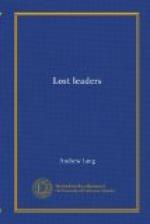Frost brings with it an enforced close-season for most of furred and feathered kind. The fox is safe enough, and, if sportsmen are right, must be rather wearying for open weather, and for the return of his favourite exercise with hounds. But even when the snow hangs out her white flag of truce and goodwill between man and beast, the British sportsman is still the British sportsman, and is not averse to going out and killing something. To such a one, wild-fowl shooting is a possibility, though, as good Colonel Hawker says, some people complain forsooth that it interferes with ease and comfort. We should rather incline to think it does. A black frost with no moon is not precisely the kind of weather that a degenerate sportsman would choose for lying in the frozen mud behind a bush, or pushing a small punt set on large skates across the ice to get at birds. Few attitudes can be more cramping than that of the gunner who skulks on one knee behind his canoe, pushing it with one hand, and dragging himself along by the aid of the other. Then, it is disagreeable to have to use a gun so heavy that the stock is fitted with a horsehair pillow, or even with a small bolster. The whistle of widgeon and the shrill-sounding pinions of wild geese may be attractive noises, and no doubt all shooting is exciting; and a form of shooting which stakes all on one shot must offer some thrilling moments of expectation. The quarry has to be measured by number, not by size, and fifty widgeon at one discharge, or a brace of wild swans may almost serve to set against a stag of ten. {23} The lover of nature has glimpses in wild-fowl shooting such as she gives no other man—the glittering expanse of waters, the birds “all in a charm,” all uttering their cry together, the musical moan of the tide, and the “long glories of the winter moon.” But success is too difficult, equipment too costly, and rheumatism too certain for wild-fowl shooting to be reckoned among popular winter sports.




